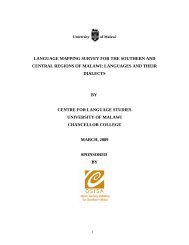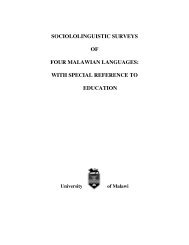languages and area spoken for chitipa - Centre for Language Studies
languages and area spoken for chitipa - Centre for Language Studies
languages and area spoken for chitipa - Centre for Language Studies
Create successful ePaper yourself
Turn your PDF publications into a flip-book with our unique Google optimized e-Paper software.
Statistics Office. The groups also relied on the group members’ knowledge of the<br />
geography of the <strong>area</strong>s to be visited. All the three groups covered every district together.<br />
In a district, each group was given a number of Chiefs/ T/As to conduct interviews.<br />
During visits, the T/A was the first person to be interviewed in order to crosscheck the<br />
census data with the TA’s knowledge on the local <strong>languages</strong> <strong>spoken</strong> in their <strong>area</strong>s. Where<br />
there were discrepancies, the groups visited such villages <strong>and</strong> administered<br />
questionnaires, conducted Focused Group Discussions <strong>and</strong> Key in<strong>for</strong>mant Interviews.<br />
Even where the in<strong>for</strong>mation given by the chiefs tallied with the census data, selected<br />
villages were visited.<br />
1.5 Instruments<br />
For purposes of triangulation of results, three instruments <strong>for</strong> data collection were used:<br />
Individual Questionnaires, Focused Group Discussions (FGDs) <strong>and</strong> Key In<strong>for</strong>mants<br />
Interviews (KIIs).<br />
1.5.1 Individual Questionnaires<br />
Questionnaires were designed to collect in<strong>for</strong>mation on the speakers’ views on their<br />
<strong>languages</strong>. The questionnaire targeted youths from 15 years <strong>and</strong> above <strong>and</strong><br />
parents/guardians both male <strong>and</strong> female. Interviews were conducted in r<strong>and</strong>omly selected<br />
villages with the guidance of the T/A. A total of seven hundred <strong>and</strong> fifty one (751)<br />
questionnaires were administered in villages in twenty-eight TAs in the five districts.<br />
Initially, it had been planned to administer about 3500 questionnaires <strong>for</strong> the whole study.<br />
However, just two days into the survey, it was observed that FGDs <strong>and</strong> KIIs yielded more<br />
reliable <strong>and</strong> accurate in<strong>for</strong>mation than individual questionnaires. In addition, most of the<br />
rural <strong>area</strong>s in the region are sparsely populated <strong>and</strong> households are situated far apart <strong>and</strong><br />
in difficult places to access them . Consequently, researchers had to walk long distances<br />
from one household to another. This resulted in fewer questionnaires being administered<br />
in a day as much of the time was spent on walking from one household to another <strong>and</strong><br />
across villages (refer to Section 4). The research team there<strong>for</strong>e decided to concentrate<br />
more on FGDs <strong>and</strong> KIIs.<br />
1.5.2 Focused Group Discussions<br />
Focused group discussions were conducted in selected villages with a group of twenty<br />
(20) participants comprising seven (7) men, seven (7) women, three (3) boys <strong>and</strong> three<br />
(3) girls. A total of sixty-one (61) FGDs were conducted during the whole study.<br />
All discussions were done in the participants’ own <strong>languages</strong>. Research team members<br />
who were conversant with the language of the <strong>area</strong> facilitated the discussions while other<br />
members of the research team took notes or co-facilitated whenever necessary.<br />
Participants in the discussions were also given an opportunity to ask questions or make<br />
comments where necessary. All discussions were recorded on tapes which were later<br />
used <strong>for</strong> report writing. The report writing was done in the evening. Group members took<br />
turns to write the reports which were later checked by the group supervisors to ensure<br />
that all the important details were captured.<br />
7





